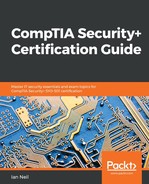Federation services are used when two different companies want to authenticate between each other when they participate in a joint venture. Think of two car manufacturers wanting to produce the best car engine in the world. Both companies have experts on engines but they want to work together to produce a super engine.
The companies don't want to merge with each other; they want to retain their own identify and have their own management in place. These are known, to each other, as third parties.
Each of these companies will have their own directory database, for example an active directory that will only have users from their domain. Therefore, normal domain authentication will not work. Let us now look at the two different domains and their directory databases:

Company A has three users in his active directory: Mr Red, Mr Blue, and Mr Green. Company B also has three users: Mr Orange, Mr Purple, and Mr Yellow. This means that they can only change passwords for the people in their own domain.
If Mr. Orange was to try and access the Company A domain he would need an account. Since he does not have an account the security administrator from Company A has no way of providing authentication. He then needs to make an agreement with Company B to set up a federation trust where the people from the other domain would need to use alternative credentials instead of a username and password or a smart card and PIN. They use extended attributes:
User-extended attributes are extended attributes used by their directory services; they are, in addition to the basic attributes:
- Employee ID
- Email address
They both have decided that the extended attributes that they will use will be the user's email address. Because an email address is easy to find or guess they will also need to use their domain password. This is known as a claim. When the exam talks about authentication using the phrase third party or extended attributes, think of federation services.
The two companies need to exchange the extended attribute information and need a special protocol to do that, so they use Security Assertion Mark-up Language (SAML) as it is XML based authentication:

Federation Services—Authentication: In this scenario Mr. Yellow is going to authenticate himself with Company A so that he can access limited resources. He contacts Company A through a web browser and it asks him for his email address and password:

Federation Services—Exchange of Extended Attributes: Company A now uses SAML to send the authentication details of Mr Yellow to Company B. Mr Yellow's domain controller confirms that they are correct:

Once Company B confirms that Mr Yellow's extended attributes are valid the Company A domain controller sends a certificate to Mr Yellow's laptop; this certificate is used next time for authentication.
